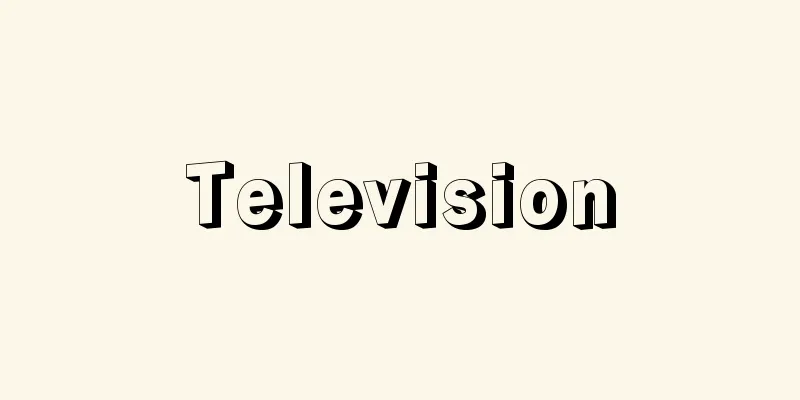Television

|
A communication method that converts an optical image into an electrical signal, transmits it wirelessly or by wire, and reproduces it as a picture on a television receiver. If an optical image is divided into small squares, it can be broken down into pixels with black and white shading. Each of these brightnesses is transmitted as an electrical signal, reproduced, and arranged in the same way as before to obtain the original image. In the past, mechanical methods were studied to scan these pixels using a Nipkow disk or a mirror wheel, but in 1933, VK Zworykin invented the iconoscope, which led to a revolutionary development. In other words, in a camera tube, an electron beam is scanned over extremely finely divided pixels to extract an electrical signal, which is then transmitted to the receiver. In Japan, this scanning is done by shifting the horizontal lines from left to right in sequence, with one screen consisting of 525 lines, and 30 images per second. These are scanned in exactly the same order to form an image on the picture tube. Broadcasting was previously mainly live, but after the development of videotape, it has been used almost exclusively. Radio waves are sent to local relay stations using microwaves, coaxial cables, etc., and then transmitted from each broadcasting station. Regular television broadcasting in Japan began in 1953 with NHK. In recent years, rapid advances in semiconductor technology have made it possible to convert received analog signals into digital signals (A/D conversion) inside the television, allowing multiple images to be displayed on the screen and increasing the number of scanning lines to reproduce clearer images. Hi-Vision, developed by NHK, is considered to have a variety of uses as the next generation of television. Digital broadcasting, which uses digital signals for transmission, has also begun in some areas. →Satellite broadcasting/CATV/Color television/Industrial television/High-definition television→Related topicsSatellite station | Journalism | Takayanagi Kenjiro | Television camera | Broadcasting | Broadcasting station | Mass communication Source : Heibonsha Encyclopedia About MyPedia Information |
|
光学像を電気信号に変換し,無線または有線により伝送,テレビ受像機により映像として再生する通信方式。光学像を細かい四角に分けていくと白黒の濃淡をもつ絵素に分解できる。この明るさを一つ一つ電気信号で伝送,再生し,前と同じに配列して原像を得る。古くはそれら絵素をニポー円板や鏡車を使用して走査する機械的方式が研究されたが,1933年V.K.ツウォリキンのアイコノスコープの発明により画期的発展をみるに至った。すなわち撮像管ではきわめて微細に分解した絵素に電子線を走査して電気信号をとり出し,受像機に伝送する。日本ではこの走査は左から右に横線を順次ずらして行われ,1画面525本,毎秒像数30枚で構成される。これを全く同じ順に走査して受像管上に結像する。放送は以前は生放送主体で行われたが,ビデオテープ開発後はほとんどがこれを利用。電波はマイクロウェーブ(マイクロ波)方式,同軸ケーブル方式などで局地中継局に送られ,それぞれの放送局から送信される。日本でのテレビの本放送は1953年NHKにより開始。 近年,半導体技術の急速な進歩により,受信したアナログ信号をテレビジョン内部でデジタル信号化(A/D変換)して,スクリーン上に複数の画面を表示させたり,走査線を多くしてより鮮明な画像を再現することが可能となった。NHKが開発したハイビジョンは次世代テレビジョンとして,さまざまな活用が考えられている。また伝送の際にもデジタル信号を使用するデジタル放送も一部開始されている。→衛星放送/CATV/カラーテレビジョン/工業用テレビジョン/高品位テレビジョン →関連項目サテライト局|ジャーナリズム|高柳健次郎|テレビカメラ|放送|放送局|マス・コミュニケーション 出典 株式会社平凡社百科事典マイペディアについて 情報 |
<<: Video phone - Terebi Denwa (English) video phone
>>: Telepathy - Telepathy (English spelling)
Recommend
Akebia pentaphylla (English spelling) Akebia pentaphylla
… [Susumu Terabayashi]. … *Some of the terminolog...
Taylor, Charles Ghankay
Born January 27, 1948. Liberian politician and reb...
Matsuzakaya Co., Ltd. - Matsuzakaya
It started as a kimono merchant Ito-ya, founded in...
Rhynchospora alba (English spelling) Rhynchosporaalba
…[Tetsuo Koyama]. … *Some of the terminology that...
In Aouanrhat (English spelling)
…The area is now a completely dry, rugged mountai...
Contact metasomatic deposit
A deposit formed in carbonate rocks (such as lime...
Diopside (English spelling)
A type of pyroxene, often light in color. It can ...
Banking Bureau
...To increase financial resources, the governmen...
mamlaka
...Of course, daula is a concept centered on the ...
Election bulletin - Senkyokouhou
A document that lists the names, careers, and poli...
Amorphous substance - amorphous substance
Solid materials are composed of atoms (molecules a...
Corythaeola cristata (English spelling)
…On the other hand, the red feathers on the head ...
Buitenzorg
...Population: 272,000 (1990). Located about 60 k...
Secrets of Annual Events - Nenjuugyoujihishou
This is a book of official affairs that records th...
Ogai - Ogai
...A general term for three large species of snai...









![Shibetsu [town] - Shibetsu](/upload/images/67cbc90648881.webp)